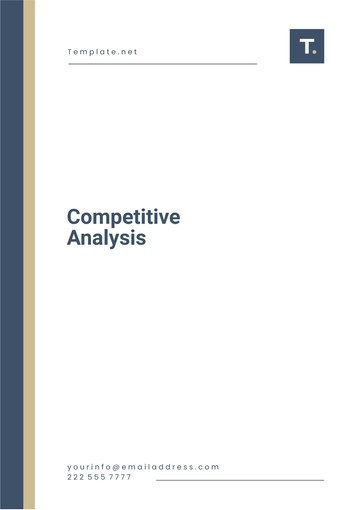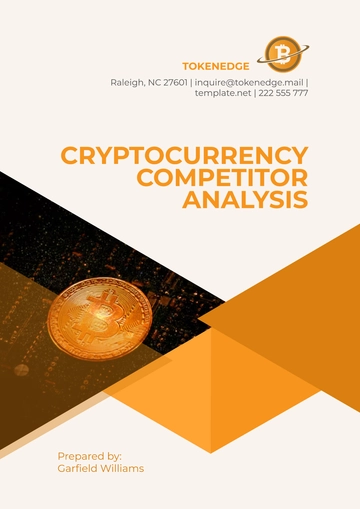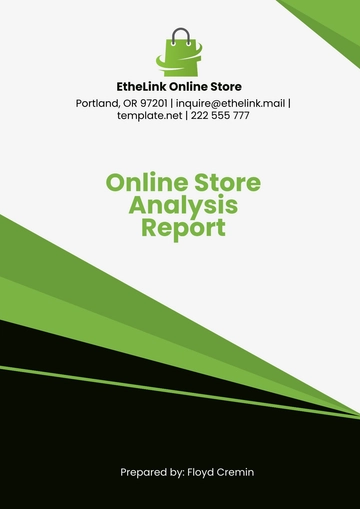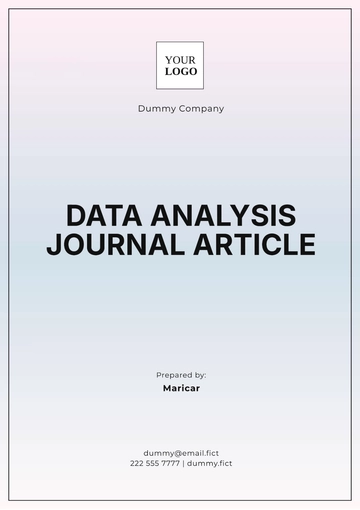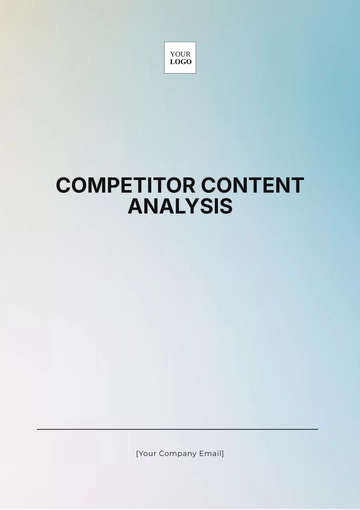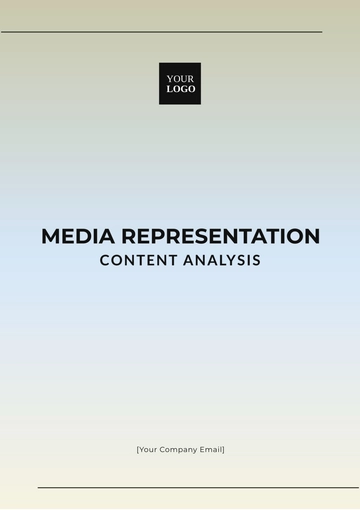Free Restaurant Social Media Analysis

I. Executive Summary
This document provides a comprehensive analysis of the social media presence of our restaurant, [Your Company Name]. The analysis reveals key data points that offer insights into our current social media performance and areas for potential improvement.
Our social media presence spans across multiple platforms, each with its unique audience and engagement levels. For instance, Facebook, our largest platform, boasts 15,000 followers, while Instagram, with 10,000 followers, shows a higher engagement rate of 3.0%. On the other hand, LinkedIn, despite having the smallest follower base of 2,500, presents opportunities for growth and increased engagement.
In terms of audience demographics, the majority of our audience falls within the 18-34 age range, with 35% aged between 18-24 and 45% between 25-34. This demographic is typically characterized by a high level of social media engagement and openness to trying new culinary experiences. Therefore, content targeting this age group should be dynamic, innovative, and interactive.
Based on these insights, it is recommended to increase the frequency of video content, especially on Instagram, to engage our younger audience. We also suggest exploring opportunities to boost our presence on LinkedIn through targeted content and engagement strategies. By implementing these recommendations, we aim to enhance our online presence, foster stronger relationships with our patrons, and drive growth for [Your Company Name].
II. Current Social Media Presence
In the rapidly evolving digital landscape, understanding the current social media presence of [Your Company Name] is crucial. It provides insights into the reach and engagement of the brand across various platforms. The following table presents a snapshot of [Your Company Name]'s social media presence:
Platform | Followers | Engagement Rate | Average Likes/Post | Average Comments/Post |
|---|---|---|---|---|
15,000 | 2.5% | 150 | 30 | |
10,000 | 3.0% | 300 | 50 | |
5,000 | 1.8% | 45 | 10 | |
2,500 | 1.5% | 30 | 5 | |
Snapchat | 3,000 | 3.5% | 100 | 20 |
A. Facebook
Facebook, with its vast user base, serves as a significant platform for [Your Company Name]. With 15,000 followers, the brand has a substantial reach. The engagement rate of 2.5% indicates a moderate level of interaction, with an average of 150 likes and 30 comments per post. This suggests that while the audience size is large, there is room to boost engagement through more interactive and engaging content.
B. Instagram
Instagram, known for its visually appealing content, has 10,000 followers for [Your Company Name]. The higher engagement rate of 3.0% compared to Facebook indicates a more active audience. With an average of 300 likes and 50 comments per post, Instagram appears to be a platform where [Your Company Name] can engage effectively with its audience.
C. Twitter
Twitter, with 5,000 followers, has a smaller audience for [Your Company Name]. However, the engagement rate of 1.8% and an average of 45 likes and 10 comments per post suggest a reasonably engaged audience. This indicates that Twitter could be leveraged better to increase both reach and engagement.
D. LinkedIn
LinkedIn, primarily a professional networking site, has the smallest follower base of 2,500. The engagement rate of 1.5% is the lowest among all platforms, suggesting that LinkedIn might not be the most effective platform in terms of audience engagement.
E. Snapchat
Snapchat, though having a smaller audience of 3,000, shows the highest engagement rate of 3.5%. This suggests that Snapchat’s audience, though smaller, is highly engaged and could be effectively targeted with the right content.
Understanding the current social media presence of [Your Company Name] across different platforms provides valuable insights into where the brand stands in the digital space. Each platform has its unique strengths and audience characteristics, and understanding these nuances is key to crafting an effective social media strategy.
The data presented in the table above provides a clear picture of where [Your Company Name] has a strong presence and where there is room for improvement. For instance, while Facebook has the largest follower base, the engagement rate is lower than Instagram and Snapchat. This suggests that while the reach on Facebook is high, the level of interaction with the audience could be improved.
On the other hand, Snapchat, despite having a smaller follower base, has the highest engagement rate. This indicates a highly engaged audience and presents an opportunity for the restaurant to further leverage this platform.
In conclusion, understanding the current social media presence is the first step towards crafting a successful social media strategy. It provides a benchmark against which the effectiveness of future social media initiatives can be measured. By focusing on improving engagement on platforms where the follower base is already strong and leveraging the strengths of each platform, [Your Company Name] can significantly enhance its social media presence.
III. Audience Demographics
A. Age Groups
Understanding the age distribution of [Your Company Name]'s audience is crucial as it helps tailor the content to the preferences of different age groups. Here is a detailed breakdown of the age groups among the restaurant's audience:
18-24 years old (35%): This age group forms the largest segment of [Your Company Name]'s audience, accounting for 35% of the total. This demographic is typically characterized by a high level of social media engagement and openness to trying new culinary experiences. Therefore, content targeting this age group should be dynamic, innovative, and interactive.
25-34 years old (45%): This age group represents the second-largest segment, making up 45% of the audience. Individuals in this age group are often established professionals who value quality dining experiences. Content for this demographic should highlight the quality of ingredients, culinary expertise, and the overall dining experience at [Your Company Name].
35-44 years old (15%): This age group accounts for 15% of the audience. They are likely to be more settled in their culinary preferences and value consistency and reliability. Therefore, content for this demographic should emphasize the consistency and reliability of the dining experience at the restaurant.
45-54 years old (5%): This age group forms the smallest segment of [Your Company Name]'s audience, comprising 5% of the total. They are likely to appreciate a more traditional dining experience. Content targeting this demographic should highlight the traditional aspects of the restaurant's offerings and the comfortable, familiar dining environment.
B. Geographical Distribution
As a restaurant, understanding where our patrons are located globally is crucial for tailoring our content and marketing strategies. The following chart and table present the geographical distribution of our audience:
Region | Percentage |
|---|---|
North America | 60% |
Europe | 20% |
Asia | 10% |
Others | 10% |
Understanding the geographical distribution of our audience allows us to create more targeted and effective marketing strategies. By tailoring our content and marketing efforts to the preferences and expectations of each region, we can enhance engagement and foster a stronger connection with our audience.
North America (60%): Our largest audience segment is from North America, accounting for 60% of the total. This suggests that our brand has a strong presence in this region. The high percentage could be attributed to factors such as the popularity of our cuisine in North America or effective marketing strategies targeting this region.
Europe (20%): Europe represents the second-largest segment, making up 20% of our audience. This indicates a significant presence in Europe, but there may be room for growth and increased engagement in this region.
Asia (10%): Asia accounts for 10% of our audience. Given the diverse culinary traditions and tastes in Asia, there could be opportunities to further tailor our offerings and marketing strategies to appeal to this audience.
Others (10%): The remaining 10% of our audience is spread across various other regions. This diverse audience segment offers us the opportunity to reach out to potential customers in regions not heavily targeted in the past.
The data presented above provides a clear picture of where we have a strong presence and where there is room for improvement. For instance, while North America has the largest audience base, there may still be untapped potential in Europe and Asia. This suggests that while our reach in North America is high, there could be opportunities for growth in other regions.
Overall, understanding the geographical distribution is a crucial step towards crafting a successful social media strategy. It provides a benchmark against which the effectiveness of future marketing initiatives can be measured. By focusing on improving engagement in regions where our audience base is already strong and leveraging the strengths of each region, we can significantly enhance our global social media presence.
IV. Content Performance
Content performance is a key indicator of how well our social media strategy is working. It helps us understand what type of content resonates with our audience and drives engagement. The following provide insights into the most and least engaging posts, as well as overall engagement trends:
A. Most Engaging Posts
The most engaging posts are those that receive the highest number of likes and comments. These posts often resonate with the audience and encourage interaction. Here are the top three most engaging posts:
Instagram Giveaway Post: This post received 500 likes and 100 comments. Giveaways are a great way to engage the audience as they provide an incentive for interaction. They also help increase our reach as participants often share the post with their network.
Facebook Live Cooking Demo: This post garnered 300 likes and 80 comments. Live cooking demos allow us to showcase our culinary skills and give our audience a behind-the-scenes look at our kitchen. This transparency can help build trust and engagement with our audience.
Twitter Holiday Specials Announcement: This post got 120 likes and 20 comments. Announcements about special offers or holiday specials can create excitement and anticipation among our audience. They also provide a reason for our audience to visit our restaurant.
B. Least Engaging Posts
The least engaging posts are those that receive the fewest likes and comments. These posts may not resonate with the audience or encourage interaction. Here are the three least engaging posts:
LinkedIn Company Update: This post received 10 likes and 0 comments. While company updates are important, they may not be as engaging for our audience. We could consider making these updates more engaging by adding a personal touch or sharing behind-the-scenes stories.
Facebook Menu Update: This post garnered 30 likes and 5 comments. While menu updates provide important information, they may not be inherently engaging. We could consider presenting these updates in a more engaging way, such as through a video or a fun graphic.
Twitter Regular Recipe Post: This post got 15 likes and 2 comments. While recipes can be interesting, regular recipe posts may not stand out in the audience’s feed. We could consider making these posts more engaging by adding a unique twist or a compelling story.
C. Engagement Trends
Understanding engagement trends can provide insights into when our audience is most active and what type of content they engage with. Our current trends indicate that engagement is consistently higher during the weekends and in the evenings on weekdays. This suggests that our audience is more likely to interact with our content during their free time. We can use this insight to optimize our posting schedule for maximum engagement. Additionally, we should continue to monitor these trends as they can change over time due to factors such as changes in our audience’s behavior or broader social media trends.
V. Recommendations
Based on the analysis of our social media presence, we have identified several strategies to enhance audience engagement and growth. These recommendations are designed to leverage our strengths and address areas of improvement:
A. Content Strategy
Our content strategy plays a crucial role in engaging our audience and promoting our brand. Here are some recommendations to enhance our content strategy:
Increase the frequency of video content: Videos are highly engaging and provide a more immersive experience for the audience. By increasing the frequency of video content, especially live videos, we can boost audience engagement.
Utilize user-generated content: User-generated content, such as customer photos or stories, can help build community trust and engagement. By sharing this content, we can foster a sense of community and encourage more interaction.
Engage actively with followers: Active engagement with our followers, such as responding to comments and messages, can help build stronger relationships with our audience. This can encourage more interaction and increase overall engagement.
B. Posting Schedule
Our posting schedule can significantly impact audience engagement. Here are some recommendations to optimize our posting schedule:
Post during peak engagement hours: Our current engagement trends suggest that our audience is most active during the weekends and weekday evenings. By focusing on posting during these peak engagement hours, we can increase the visibility of our posts.
Maintain a consistent posting schedule: Consistency can help keep our audience engaged and looking forward to our posts. By maintaining a consistent posting schedule across all platforms, we can enhance audience engagement.
C. Platform-Specific Recommendations
Each social media platform has its unique features and audience characteristics. Here are some platform-specific recommendations:
Instagram: Instagram offers features like stories and IGTV for longer content. By utilizing these features, we can provide a variety of content and increase engagement.
Facebook: Facebook allows us to engage with community groups and host events. By engaging with these groups and hosting more events, we can increase our visibility and build a stronger community around our brand.
Twitter: On Twitter, we can increase the frequency of our posts and use trending hashtags to increase our visibility and attract more followers.
VI. Conclusion
The social media analysis of our restaurant, [Your Company Name], has provided valuable insights into our current online presence and engagement levels. We’ve identified key areas of strength, such as our substantial reach on Facebook and high engagement rate on Instagram. These platforms, along with the others, serve as vital tools in connecting with our patrons, promoting our offerings, and building a strong brand presence.
However, the analysis also highlighted areas for potential improvement. For instance, despite having a significant follower base on LinkedIn, the engagement rate on this platform is relatively low, indicating a need for more engaging content or a revised strategy. Moving forward, we will leverage these insights to refine our social media strategy, with the ultimate goal of enhancing our online presence, fostering stronger relationships with our patrons, and driving growth for [Your Company Name].
- 100% Customizable, free editor
- Access 1 Million+ Templates, photo’s & graphics
- Download or share as a template
- Click and replace photos, graphics, text, backgrounds
- Resize, crop, AI write & more
- Access advanced editor
Analyze online presence with the Restaurant Social Media Analysis Template from Template.net! This editable template assists in analyzing social media performance. Customize your analysis to focus on key metrics using the customizable sections. The AI Editor Tool aids in generating insightful content, helping you refine your social media strategies immediately!
